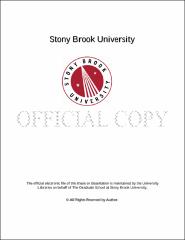| dc.identifier.uri | http://hdl.handle.net/11401/77650 | |
| dc.description.sponsorship | This work is sponsored by the Stony Brook University Graduate School in compliance with the requirements for completion of degree. | en_US |
| dc.format | Monograph | |
| dc.format.medium | Electronic Resource | en_US |
| dc.language.iso | en_US | |
| dc.publisher | The Graduate School, Stony Brook University: Stony Brook, NY. | |
| dc.type | Dissertation | |
| dcterms.abstract | Mid-infrared emissivity spectra, while useful for quantifying mineral abundance, are dependent on a variety of other factors, including grain size. At present, scattering models are not fully able reproduce this dependence, especially for very fine-grained powders (d~<60μ m) typical of planetary regolith. Previous studies have modeled emissivity spectra of mineral powders by using Mie single scattering theory coupled with a radiative transfer model, such as Hapke [1993]. Chapter 2 of this work uses multiple scattering T-matrix code (from Mackowski and Mishchenko, 2011) to calculate the scattering coefficients for a cluster of spheres, rather than a single sphere as in Mie theory. I acquired emissivity spectra of highly uniform silica glass spheres, normally used for sieve calibration, for comparison to modeled spectra. Then, I calculated optical constants of the glass from micro-FTIR reflectance spectra of polished grains mounted on a petrographic slide. Modeled emissivity spectra computed with this T-matrix/radiative transfer hybrid method show a marked improvement over Mie-radiative transfer hybrid models, especially for smaller grain sizes. The complex index of refraction (ñ =<italic>n</italic>+i<italic>k</italic>) as a function of wavelength, where <italic>n</italic> and <italic>k</italic> are often referred to as optical constants, is an essential input into radiative transfer models. Hence, quantitative estimates of mineral abundance from remote sensing data require that optical constants are known for a comprehensive set of relevant minerals. While many geologically abundant materials are monoclinic or triclinic, due to both the additional complexity of the models needed and the increased effort required to orient these samples, very few sets of optical constants have been measured for lower-symmetry minerals. Chapter 3 describes how optical constants were calculated from polarized mid-infrared reflectance spectra of oriented single-crystals of five natural samples in the monoclinic crystal system, which include four pyroxene samples and one orthoclase sample. Lastly, in Chapter 4, remote sensing emissivity data from the Diviner Lunar Radiometer Experiment, along with lunar environment laboratory measurements of mineral mixtures, are used to establish constraints on the absolute abundance of olivine at sites where it has been detected by the visible/near-infrared instruments Moon Mineralogy Mapper and Kaguya Spectral Profiler. The two main results of this section are: 1) spectra do not mix linearly at these wavelengths for particles sizes typical of lunar regolith and 2) Diviner data are consistent with a wide range in olivine abundances at these sites. | |
| dcterms.available | 2017-09-20T16:53:11Z | |
| dcterms.contributor | Nekvasil, Hanna | en_US |
| dcterms.contributor | Glotch, Timothy D | en_US |
| dcterms.contributor | Rogers, A.Deanne | en_US |
| dcterms.contributor | McLennan, Scott | en_US |
| dcterms.contributor | Bandfield, Joshua. | en_US |
| dcterms.creator | Arnold, Jessica Anne | |
| dcterms.dateAccepted | 2017-09-20T16:53:11Z | |
| dcterms.dateSubmitted | 2017-09-20T16:53:11Z | |
| dcterms.description | Department of Geosciences. | en_US |
| dcterms.extent | 170 pg. | en_US |
| dcterms.format | Monograph | |
| dcterms.format | Application/PDF | en_US |
| dcterms.identifier | http://hdl.handle.net/11401/77650 | |
| dcterms.issued | 2014-12-01 | |
| dcterms.language | en_US | |
| dcterms.provenance | Made available in DSpace on 2017-09-20T16:53:11Z (GMT). No. of bitstreams: 1
Arnold_grad.sunysb_0771E_11923.pdf: 7895297 bytes, checksum: 8cfed1c1ea927926961f089bcb981917 (MD5)
Previous issue date: 1 | en |
| dcterms.publisher | The Graduate School, Stony Brook University: Stony Brook, NY. | |
| dcterms.subject | Geology | |
| dcterms.subject | lunar geology, mid-infrared spectroscopy | |
| dcterms.title | Refining mid-infrared emission spectroscopy as a tool for understanding planetary surface mineralogy through laboratory studies, computational models, and lunar remote sensing data | |
| dcterms.type | Dissertation | |

